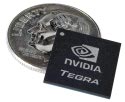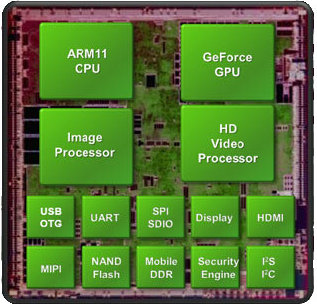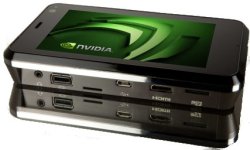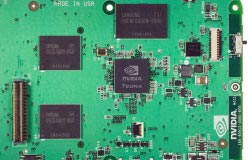Nvidia counters Atom with ARM11 SoCs — but where’s the Linux?
Jun 5, 2008 — by LinuxDevices Staff — from the LinuxDevices Archive — 2 views Nvidia has added to its family of ARM11-based SoCs for mobile Internet devices (MIDs). For now limited to Microsoft Windows Mobile, the Tegra 600 and 650 boast IDE interfaces, HD encoding/decoding, and 10 times better power efficiency than x86-based alternatives, Nvidia suggests.
Nvidia has added to its family of ARM11-based SoCs for mobile Internet devices (MIDs). For now limited to Microsoft Windows Mobile, the Tegra 600 and 650 boast IDE interfaces, HD encoding/decoding, and 10 times better power efficiency than x86-based alternatives, Nvidia suggests.
(Click here for a larger view of Nvidia's Tegra)
Nvidia, best known for its graphics processors and x86 chipsets, announced its foray into ARM-based mobile applications processors only recently, with the launch of the APX 2500 in February. Now, NVidia has added two more parts to its SoC line, which it is now calling “Tegra.”
Touted capabilities of the three Tegra models announced so far, including the new 600-series parts and original APX2500, include:
- Tegra APX2500 — 600MHz, 720p HD encode/decode, screens to 854 x 480
- Tegra 600 — 700MHz, 720p HD encode/decode, screens to 1280 x 1024
- Tegra 650 — 800MHz, 720p encode, 1080p decode, displays to 1680 x 1050
Besides their faster clocks and higher-resolution display support, both of the new 600-series Tegra parts boast IDE support, making them suitable for hard disk-equipped devices. Other touted features include:
- Dual displays and HDMI video out
- Internal display can be used for control applications while video plays out over HDMI
- ARM11-based cores support ARM's “MPCore” interconnect technology
- Audio playback of 130 hours, or video playback of 30 hours
Nvidia has not released formal packaging information, but touts Tegra as the “world's smallest computer on a chip.” The above photo suggests that the SoCs are smaller than a dime. The diagram below suggests they integrate an ARM11 core, HD video processor, imaging processor, audio processor, and an ultra-low power GeForce graphics processing unit.

Nvidia's Tegra
The Tegras' ULP GeForce core has the following touted features and benefits:
- OpenGL for Embedded Systems (OpenGL ES) 2.0 compatibility
- Direct 3D Mobile
- Programmable pixel shader
- Programmable vertex and lighting
- Coverage Sampled Anti-aliasing (CSAA) support
- Advanced 2D graphics
Development platform
When it announced the APX 2500, Nvidia said it would partner with a variety of vendors to integrate the SoC into a Windows Mobile-based development platform. Partner integrations announced at the time included Atheros' ROCm wireless networking, Infineon's XMM 6080 HSDPA modem technology, NXP's PCF50626 power management unit, and Wolfson's WM8753 audio codec, Nvidia said.


Nvidia's Tegra development platform (left) and main board (right)
(Click to enlarge)
The company has now released images of a similar development platform for the Tegra 600 and 650 (above left). Not much bigger than a cell phone, it includes features such as a USB port, HDMI output, and a microSD slot. An image of the platform's main board (above right) shows a Tegra processor in the center, surrounded by what appear to be Samsung DRAM and flash memory chips.
In a recent analysis piece on Linux-Watch, Henry Kingman points out that the Tegra could prove to be a capable challenger against the Intel Atom, along with the Texas Instruments OMAP3xxx processors and the Via Nano. Kingman points out that the Tegra is both more compact and more power efficient than the Atom. However, if Nvidia limits the Tegra to Windows Mobile, the chip's success could be hampered.
Asked about future Linux support, NVidia Spokesperson Andrew Humber replied, “Market demands will always dictate the direction in which we take a
product, and this is true of all of NVidia's businesses. However, at this
time we are focused entirely on Windows Mobile and Windows CE.”
Jen-Hsun Huang, president and CEO of Nvidia, said, “Our vision was to create a platform that will enable the second personal computer revolution — which will be mobile-centric. Merely shrinking down a 50-Watt PC architecture will not create the discontinuity this industry needs.”
Availability
Nvidia says the Tegra 600 and 650 will be offered with a complete Windows Mobile board support package, and should be available in complete consumer products towards the end of this year. Neither pricing nor support for additional operating systems was discussed.
This article was originally published on LinuxDevices.com and has been donated to the open source community by QuinStreet Inc. Please visit LinuxToday.com for up-to-date news and articles about Linux and open source.